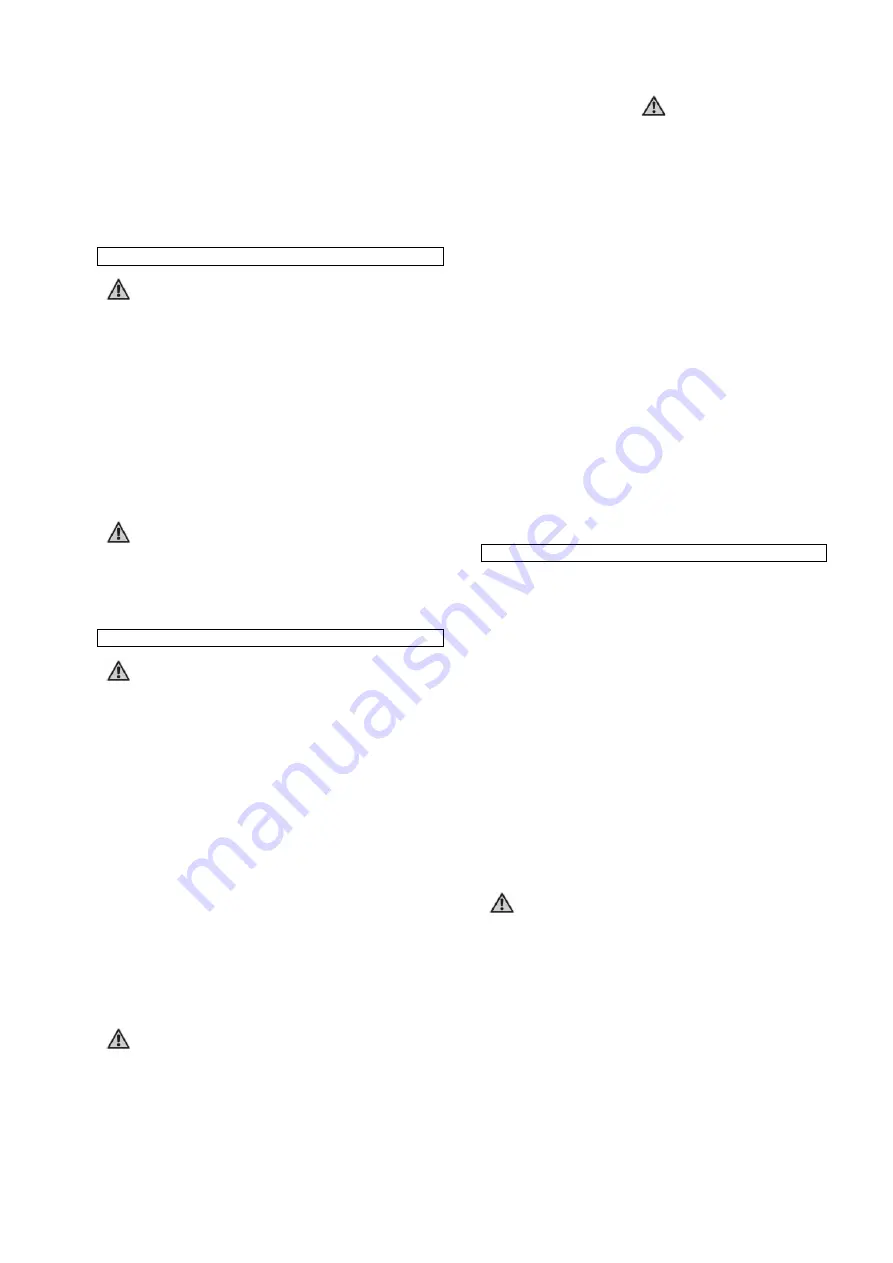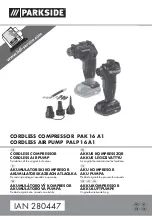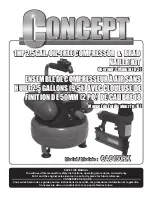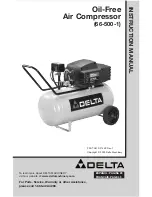
You should remove the transport stopper of the air filter and
screw up the enclosed air filter instead of the stopper. Put the
air filter on the thread and tighten in the clockw ise direction by
hand. When you learn from the very beginning that the air
filter is difficult to tighten, check please once more w hether it
is properly put on the thread because otherw ise the plastic
thread at the air filter could be damaged.
It is recommended to clean the air filter every 100 to 200
hours of operation.
(Required position of the suction opening
can be fixed by tightening of the w ing-nut).
Operation
Before every adjustment or maintenance of the
compressor the plug must be pulled from the socket.
Switching on and/or off
The compressor can be sw itched on by pulling for the
sw itching-on knob
(14)
or sw itched off by pressing it again.
Operating pressure adjustment
The operating pressure can be easily adjusted, rotate the
rotating knob
(6)
in the
+ direction
, the
working pressure
thus
increases
. Rotate the rotating knob
(6)
in the
–
direction
, the
working pressure decreases.
The compressor has an automatic safety valve that
releases the pressure in case of overpressure. Here you
can release the pressure manually pulling the ring of the
valve (7).
Pay attention to the required delivered amount for your
pneumatic device used! The pressure itself
IS NOT
decisive
for faultless or sufficient operation. Short sw itching on of the
compressor after a long putting aside w ithout using is normal!
Have possible scheduled repairs performed exclusively by
trained specialist staff.
Inspections and maintenance
Always pull the plug from the socket before any
maintenance work on the machine.
Before longer-term period of compressor inactivity it is
advisable to put several drops of oil at the insert of the air
filter that results in the preliminary lubrication of w alls of
compressor cylinder at next start.
For cleaning of plastic parts use a damp cloth. Do not use
cleansing agents, solvents or sharp objects.
After every use
Remove dust from ventilation openings and moving parts.
Periodically
Periodically (
min. monthly
) remove the condensing w ater
from the air receiver; not observing could result in voiding the
w arranty against corroding through – otherw ise the
compressor is maintenance-free.
(The condensing w ater could stain brow nish thanks to the air
receiver surface)
1.
Pull the plug from the socket!
2.
Open the mud-discharge valve at a low pressure in the
air receiver (max. 1 bar) and drain the condensing w ater
completely. (use a suitable vessel)
3.
Close the valve.
Oil replacement: (Fig. 2)
Because w hen piston is running up scales can be formed, it is
unconditionally necessary to perform the oil replacement after
first
10
hours of operation. For this purpose our compressor
oil (order No.: 40056) is recommended. Later it is necessary
to replace the oil every
100
to
200
hours of operation
depending on the frequency of compressor use. To replace
the oil loosen the draining screw
(16)
and catch the drained
used oil into a suitable vessel.
Observe regulations for used oil disposal unconditionally
and dispose it in a specialist way in the used oil
collecting point.
Now again fasten the draining screw and fill the oil up to the
centre of the red point in the inspection sight
(15)
.
Air filter:
Sometimes it is necessary to clean the insert of the air filter;
to do so, remove the w ing-nut from the air filter cover and
remove the foam filter. It can be cleaned w ith w arm soap lye.
Dry the foam filter and insert again. Now reattach the air filter
cover.
Fuse against overheating:
(depending on model)
If the compressor is loaded by a technical defect or possibly
also by continuing operation, the pow er feed w ill be
automatically interrupted by a thermo-sw itch. If such situation
occurs it is advisable to disconnect the compressor from the
mains and let it cooled dow n for approx. 5 minutes. If the
compressor does not start after certain period of operation, let
it cooled dow n for additional 3 minutes.
Pressure switch:
The compressor is equipped w ith an automatic pressure
sw itch that sw itches the compressor off after reaching the
maximum operating pressure and w hen the demand for air
occurs it sw itches the compressor on again. The sw itch-on
pressure 7.5 bar, max. pressure 10 bar.
Remedy of faults
Obs er v e s af ety ins tr uctions and ins tructions f or
maintenanc e!
The circuit breaker of the motor inter r upts the pow er
f eeding.
In case of any fault (e.g. overheating) the circuit breaker of
the motor activates itself and interrupts the pow er feeding.
In this case:
Sw itch off the compressor using the sw itch. Wait for a w hile.
Press the circuit breaker of the motor.
Sw itch the compressor on again.
The circuit breaker of the motor should activate again:
Sw itch the compressor off using the sw itch.
This interrupts the pow er feeding.
Contact the nearest service partner.
Thermal protection of the motor
The compressor is also equipped w ith
thermal protection
of the motor. When overheated the thermal protection
activates and the pow er feeding interrupts. There is a
danger that the compressor is damaged. Contact the
service unconditionally !
Danger
Risk of injury! The compressor could automatically start
again after cooling dow n (approx. 5 min).
Pressure relief does not work
The pressure relief is deactivated as a result of pulling
the plug out of the socket or mains voltage drop w hen
the compressor is on.
Pressure relief reactivation:
Sw itch the compressor off using the sw itch. The machine
relieves. Insert the plug into the socket.
Sw itch the compressor on using the sw itch.
NOTICE:
In compressors w ith output pow er exceeding 2.0 kW
relatively high starting currents could be generated. These
currents could activate the fuses against overheating of your
residential installation.
This is not a defect!
In this case
contact your electrician w ho w ill install suitable protection for
you.
Summary of Contents for 50066
Page 2: ...1 1 14 12 1 10 15 13 8 7 16 6 5 2 3 4 9 2 3 ...
Page 3: ......
Page 66: ......
Page 67: ......
















































